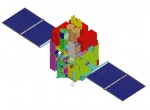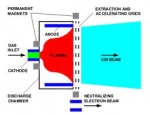
Copernical Team
Astrosat
Astrosat is India's first dedicated astronomy satellite and is scheduled to launch on board the PSLV in 2012. After the success of the satellite-borne Indian X-ray Astronomy Experiment (IXAE), which was launched in 1996, the Indian Space Research Organization (ISRO) has approved further development for a full fledged astronomy satellite - Astrosat.
A large number of leading astronomy research institutions in India and abroad are jointly building various instruments for the satellite. Important areas requiring broad band coverage include studies of astrophysical objects ranging from the nearby solar system objects to distant stars, to objects at cosmological distances; timing studies of variables ranging from pulsations of the hot white dwarfs to active galactic nuclei (AGN) with time scales ranging from milliseconds to few hours to days.
Astrosat is currently proposed as a multi-wavelength astronomy mission on an IRS-class satellite into a near-Earth, equatorial orbit by the PSLV. The 5 instruments on-board cover the visible (320-530 nm), near UV(180-300 nm), far UV(130-180 nm), soft X-ray (0.3-8 keV and 2-10 keV) and hard X-ray (3-80 keV and 10-150 keV) regions of the electromagnetic spectrum.
Mission
Astrosat will be a proposal-driven general purpose observatory, with main scientific focus on:
- Simultaneous multi-wavelength monitoring of intensity variations in a broad range of cosmic sources
- Monitoring the X-ray sky for new transients
- Sky surveys in the hard X-ray and UV bands
- Broadband spectroscopic studies of X-ray binaries, AGN, SNRs, clusters of galaxies and stellar coronae
- Studies of periodic and non-periodic variability of X-ray sources
Bigelow Aerospace
Bigelow Aerospace is a North American space technology company that is pioneering work on expandable space station modules.
Bigelow is pioneering a new market in a flexible and configurable set of space habitats.
Aerostudi
AEROSTUDI, a certified company with integration of all necessary skills, from requirements definition to full production, with savings in terms of cost and time, keeping the highest quality standards.
Since 1989 AEROSTUDI has been developing and manufacturing mechanical systems and sub-systems as well as high performance light metallic and composite structures in the aerospace field.
Avanti Communications
Avanti Communications sells satellite data communications services to telecoms companies which use them to supply enterprise, institutional and consumer users.
Avanti's first satellite, called HYLAS 1, launched on 26th November 2010 and was a superfast Ka band satellite launched in Europe. Avanti's second satellite, called HYLAS 2, will launch on 2nd August 2012. It will extend Avanti's coverage to Africa, the Caucuses and the Middle East. HYLAS 3 will also serve Africa in 2015.
XIPS - Xenon Ion Propulsion System
XIPS is a com-mercial electron bom-bardment thruster (also known as an electrostatic ion thruster) – a form ion propulsion – that is a product of Hughes Space and Communications Company, which, in 2000, became part of Boeing Satellite Systems.
XIPS (pronounced "zips") employs the heavy inert gas xenon as a propellant. It was first used operationally aboard the PAS-5 (PanAmSat-5) communications satellite in 1997 and has since been fitted to many other geosynchronous satellites for use primarily in station-keeping. In a XIPS, xenon atoms are injected into an ionization chamber and ionized by electron bombardment. The propellant is then electrostatically accelerated through a series of biased grids. Ions, ejected by XIPS, travel in a stream at a speed of 30 km/s (62,900 mph), nearly 10 times that of a conventional chemical thruster. The high efficiency of the system leads to a reduction in propellant mass of up to 90% for a satellite designed for 12–15 years operation.
For example on a XIPS equipped Boeing 702 satellite, four 25-cm thrusters provide economical station keeping, needing only 5 kg of fuel per year. Boeing asserts that this is "a fraction of what bipropellant or arcjet systems consume". Boeing further asserts, that a XIPS can be used for final orbit insertion and has orders ( source: Wikipedia, Boeing_702 ) for spacecraft utilizing only ion thrusters. This conserves even more payload mass, as compared to using an on-board liquid apogee engine.
DA-Design
DA-Design Oy was founded in 1995, specialising in electronics and software engineering. Since then company has generated a wide competence in embedded systems related software, electronics, mechanic, RF and microwave engineering.
Space Business became a part of DA-Design in 2007 with the merging of DA-Design & Ylinen. DA-Design carries out projects as a subcontractor for major space companies and European Space Agency ESA. Typically these projects include system and equipment design, manufacturing and testing. DA-Design makes subsystems into satellites and performs technology development for the future satellites.
New facilities enable space quality equipment manufacturing for both electrical and mechanical parts. Assembly and testing is done in a purpose built clean room facility. Measurements are mainly carried out in DA-Design in-house facilities with a possibility to test in a nominal space environment, vacuum. The clean room area contains all needed measurement equipment and simulation of space vacuum and temperatures down to +4 ˚K.
Launchspace Training
Launchspace Training is providing specialised training to the international space community.
Since 1970, thousands of space industry professionals have been attending high-intensity professional development courses presented by leading experts in almost every aspect of space flight, launch vehicles and spacecraft. Most experienced space engineers and technologists are familiar with Launchspace’s reputation for quality course content and presentation. No one else can offer the level of quality, expert content and ustomization of these courses. Only Launchspace is dedicated to training space professionals!
SSBV Aerospace & Technology Group
SSBV is a technology driven organisation, active in the domains of (aero)Space, Remote Sensing & Monitoring, Defence & Security and the development of High-Tech Systems.
Based on in-house technology, engineering, assembly and test skills, SSBV is able to provide system, subsystem and unit level solutions.
Since its establishment as Satellite Services B.V. in 1985, SSBV has evolved into a group of companies operating world-wide.
European Space Policy Institute (ESPI)
The European Space Policy Institute (ESPI) provides decision-makers with an informed view on mid- to longterm issues relevant to Europe’s space activities. In this context, ESPI acts as an independent platform for developing positions and strategies.
ESPI was established following a decision by the Council of the European Space Agency (ESA). Based in Vienna, it is structured as an association under Austrian Law. It incorporates a number of member institutions drawn from European agencies, operators and companies.
Logica plc
Logica is a global IT and management consultancy company headquartered in Reading, United Kingdom.
Logica is a management consultancy, outsourcing and IT services and solutions company. Its activities include supporting the missions of over 150 orbiting satellites.









